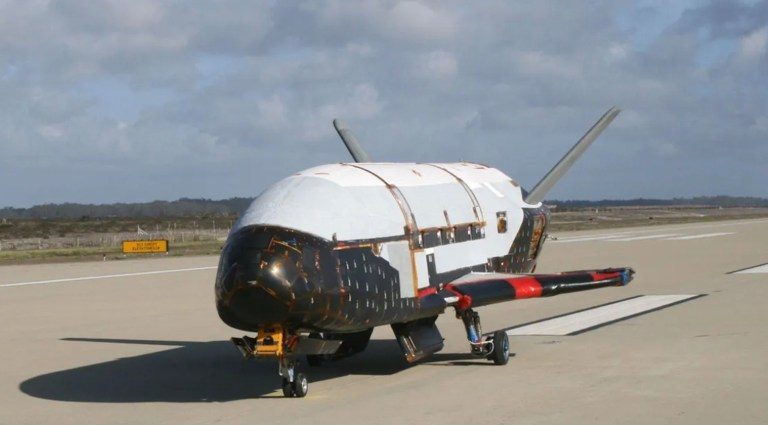The US has introduced a slew of new air-based nuclear weapon delivery methods in a bid to upgrade American deterrence against evolving threats but at the risk of sparking a new nuclear arms race with China.
This month, The Warzone reported that the B-21 Raider, the world’s second known stealth bomber, successfully made its maiden flight over Palmdale’s Plant 42 in California.
The flight was an essential phase of the bomber’s test campaign overseen by the Air Force Test Center and the B-21 Combined Test Force of the 412th Test Wing which aims to develop long-range, survivable and penetrating strike capabilities.
The Warzone report mentions that the first operational B-21s should enter service in the mid-2020s and will eventually replace the US Air Force’s fleet of B-2 and B-1 bombers, the former of which can deliver nuclear munitions. It says that Ellsworth Air Force Base in South Dakota is scheduled to receive the first batch of B-21s.
The USAF’s website describes the B-21 as “a dual-capable penetrating strike stealth bomber capable of delivering both conventional and nuclear munitions.”

Moreover, Defense Blog reported this month that SpaceX Falcon Heavy is set to launch the USAF’s secretive X-37B spaceplane, marking a historic milestone. Defense Blog notes that the spaceplane will be operated by the Department of the Air Force Rapid Capabilities Office in collaboration with the US Space Force.
The mission, known as OTV-7, is scheduled for December 2023 from Kennedy Space Center, Florida and will aim to conduct various experiments including on operating the spaceplane in new orbital regimes, testing future space domain awareness technologies and exploring the radiation effects on NASA materials.
It also mentions that the X-37B can bring experiments back to Earth for further study, a feat previously achieved by NASA’s Shuttle Orbiter.
However, the X-37B may also have unstated military purposes. As early as the 1950s and 1960s, the US conceptualized space planes as a fractional orbital bombardment system (FOBS), although it ultimately opted for a conventional fleet of manned bombers. Significantly, China may already have tested such a hypersonic weapon in August 2021.
Asia Times reported this month that the Biden administration announced the development of a next-generation air-dropped nuclear gravity bomb, known as B61-13, in response to fast-evolving security threats from China and Russia.
The B61-13 is intended to be used against hardened and large-area military targets with a yield of 360 kilotons. The US is expected to produce around 50 B61-13s, with production likely on the back end of the B61-12’s production schedule in 2025. It is speculated that the B61-13 would be restricted to bombers such as the B-2 and B-21.
Moreover, Asia Times reported last month on US tests of the AGM-181A Long Range Stand-Off (LRSO) cruise missile to bolster its air-based nuclear deterrent against new rising threats from China and Russia.
The AGM-181A is part of the LRS FoS and has undergone nine successful major flight tests, demonstrating its high survivability with a stealthy airframe. The AGM-181A LRSO is the only solution to keep the B-52H bomber nuclear-capable and will ensure the B-21’s stealth technology remains effective against evolving military technology and advanced air defenses.
The air-based leg of the US nuclear triad is the first and oldest in its nuclear deterrent. Unlike the land and sea-based legs, aircraft can be rerouted or recalled at the last moment, offering commanders more tactical flexibility.
At the end of the Cold War, the US downsized its nuclear arsenal and focused instead on strategic deterrence. In contrast, China and Russia continued to expand their nuclear arsenals, developing tactical nuclear weapons for battlefield use as opposed to strategic deterrence and as a backstop for conventional military operations.
Space-based nuclear weapons offer several advantages over other delivery systems. A FOBS can strike at any point on the planet much faster than an intercontinental ballistic missile (ICBM), evade missile defense systems, generate strategic ambiguity and uncertainty, and is potentially more survivable than air, sea or land-based systems.

While the US is a signatory to the 1967 Outer Space Treaty, which forbids placing nuclear weapons in space, the treaty does not ban all military activities in space. Nor does it prohibit placing weapons in space that are not weapons of mass destruction (WMD).
Increased nuclear threats from China and Russia may give the US renewed incentive to look at the feasibility of space-based nuclear weapons, though deployment could have unforeseen consequences for strategic stability.
While US pundits have called for the expansion of America’s nuclear arsenal in response to China and Russia’s nuclear modernization, others argue against to avoid a destabilizing new nuclear arms race.
In a Foreign Affairs article this month, M Taylor Fravel and other writers say that China is concerned about US development of offensive and defensive weapons systems that could negate its nuclear deterrent, noting that the US is building new conventional weapons that could be used to attack China’s nuclear forces, a strategy known as conventional counterforce.
Fravel and others mention that this could lead to the attacker launching a first strike in situations where nuclear weapons are not used, undermining strategic stability.

They also point out that China is concerned that enhanced US missile defenses could undermine China’s longtime strategy of “assured retaliation,” which allows for a nuclear counterattack after an enemy’s first strike. The US’s withdrawal from the 1987 Intermediate Nuclear Arms Forces Treaty (INF) has amplified these concerns.
Fravel and other writers say that while China’s nuclear buildup lacks transparency, its debate has focused on improving its deterrent system. They mention that Chinese experts have discussed ways to strengthen China’s nuclear deterrent, including by reducing reaction time, deploying missile defenses and considering strikes on systems that support US missile defense.
They point out that China’s nuclear arsenal may offer options beyond retaliatory strikes, potentially leading to a more offensive strategy.

